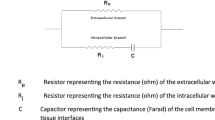Abstract
The short-time behavior of viscoelastic materials has been traditionally studied on the millisecond time scale using steady sinusoidal excitation to measure the complex modulus and optical functions. A technique has now been developed for determining the short-time inverse optical-creep function on the microsecond time scale, using wave propagation in a rod. The method is demonstrated by characterizing an epoxy material in the time regime from 1 μs to 100μs.
Similar content being viewed by others
Abbreviations
- B i :
-
coefficients in a Galerkin approximation
- C :
-
elastic stress-optic coefficient, Pascals
- c :
-
speed of light, m/s
- E :
-
integrated square error in Galerkin approximation
- \(\underset{\raise0.3em\hbox{$\smash{\scriptscriptstyle\thicksim}$}}{e}\) :
-
deviatoric strain tensor
- e i :
-
base functions for Galerkin approximation
- G :
-
shear relaxation modulus, Pascals
- h :
-
thickness of model, cm
- I i :
-
initial light intensity, W/m2
- I :
-
measured light intensity, W/m2
- K 2 :
-
polariscope calibration constant, W/m2
- L1, L2 :
-
polariscope stations
- M1, M2 :
-
magnet stations
- m :
-
actual fringe order (measured — residual)
- m i :
-
residual fringe order
- m 1 :
-
measured fringe order
- \(\underset{\raise0.3em\hbox{$\smash{\scriptscriptstyle\thicksim}$}}{n}\) :
-
deviatoric refraction tensor
- n 1 , n 2 :
-
principal values of\(\underset{\raise0.3em\hbox{$\smash{\scriptscriptstyle\thicksim}$}}{n}\)
- S :
-
deviatoric stress tensor, Pascals
- T :
-
total test time, s
- t :
-
time, s
- α:
-
angle between direction of polarization and principal axis of\(\underset{\raise0.3em\hbox{$\smash{\scriptscriptstyle\thicksim}$}}{\sigma }\), rad
- Δ:
-
birefringence
- \(\delta _{ij}\) :
-
=1i=j
- \(\delta _{ij}\) :
-
=0i≠j
- \(\underset{\raise0.3em\hbox{$\smash{\scriptscriptstyle\thicksim}$}}{\varepsilon }\) :
-
strain tensor
- λ:
-
wavelength of light, nm
- \(\underset{\raise0.3em\hbox{$\smash{\scriptscriptstyle\thicksim}$}}{\sigma }\) :
-
stress tensor, Pascals
- \(\sigma _1 ,\sigma _2\) :
-
principal values of\(\underset{\raise0.3em\hbox{$\smash{\scriptscriptstyle\thicksim}$}}{\sigma }\), Pascals
- \(\sigma _A\) :
-
stress calculated from Galerkin approximation, Pascals
- τ:
-
dummy variable of integration
- \(\tau _i\) :
-
characteristic time of base functione i (t), s
- Φ:
-
\(\frac{{2\pi c}}{{h\omega }}\Omega\), Pascals/fringe
- ϕ:
-
isoclinic angle, rad
- ψ:
-
optical-creep function, fringes/Pascal
- Ω:
-
inverse optical-creep function, Pascals
- ω:
-
frequency of light, Hz
References
Nolle, A. W., “Methods for Measuring Dynamic Mechanical Properties of Rubberlike Materials,”Jnl. of Appl. Physics,19,753–774 (1948).
Ferry, L. D., Viscoelastic Properties of Polymers, John Wiley and Sons, Inc., New York (1961).
Gottenberg, W. G. andChristensen, R. M., “An Experiment for the Determination of the Mechanical Property in Shear for a Linear, Isotropic Viscoelastic Solid,”International Jnl. of Engrg. Science,2(1),45–57 (1964).
Stein, R. S., Onogi, S. andKeedy, D. A., “The Dynamic Birefringence of High Polymers,”Jnl. of Polymer Science,57,801–821 (1962).
LeGrand, D. G. andErhardt, P. F., “Rheo-Optical Properies of Polymers,”Trans. Soc. Rheology,6,301–315 (1962).
LeGrand, D. G., “Rheo-Optical Properties of Polymers VI. Dynamic Birefringence,”Jnl. Polymer Science,2,931–942 (1964).
Read, B. E., “A Treatment of Static and Dynamic Bire-fringence in Linear Amorphous Polymers by an Extension of the Molecular Theory of Viscoelasticity,”Polymer,3,143–152 (1962).
Daniel, I. M., “Dynamic Properties of a Photoviscoelastic Material,”Experimental Mechanics,6(5),225–234 (1966).
Daniel, I. M., “Viscoelastic Waves Interaction with a Cylindrical Cavity,”Jnl. of the Engrg. Mech. Div., Proc. of the ASCE,92(EM 6),25–42 (1966).
Daniel, I. M., “Stresses around a Circular Hole in a Viscoelastic Plate Subjected to Point Impact on One Edge,”Developments in Mechanics,3(1),Solid Mech. and Matls.,491–507 (1967).
Sackman, J. L., “Uniformly Progressing Surface Pressure on a Viscoelastic Half-Plane,”Proc. 4th U.S. Nat. Cong. Appl. Mech.,2,1067–1074 (1962).
Chu, B. T., “Stress Waves in Isotropic Linear Viscoelastic Materials,”Jour. de Mechanique,1(4),439–462 (1962).
Valanis, K. C., “Wave Propagation in Viscoelastic Solids with Measured Relaxation or Creep Functions,”Proc. Fourth Int. Cong. on Rheology, Part 2,Interscience Publ, N. Y., 261 (1965).
Dill, E. H., “Photoviscoelasticity,” Mechanics and Chemistry of Solid Propellants, Proc. of the Fourth Symposium on Naval Structural Mechanics, (Edited by Eringen) (1965).
Dill, E. H., and Fowlkes, C., NASA CR 444, (1966).
Sackman, J. L., andKaya, I., “On the Determination of Very Early-Time Viscoelastic Properties,”J. Mech. Phys. Solids,16,212–132 (1968).
Sackman, J. L. andKaya, I., “On the Propagation of Transient Pulses in Linearly Viscoelastic Media,”Jnl. Mech. Phys. Solids,16,349–356 (1968).
Kaya, I., Very Early Time Characteristics of Linear Viscoelastic Materials, PhD Thesis, University of California, Berkeley (1967).
Ripperger, E. A. andYeakley, L. M., “Measurement of Particle Velocities Associated with Waves Propagating in Bars,”Experimental Mechanics,3(2),47–56 (1963).
Peeters, R. L., Dynamic Studies in Photoviscoelasticity, PhD Thesis, University of Washington, Seattle (1973).
Parmerter, R. R. andRahn, J., “A Method of Simultaneously Recording Full-field Isoclinic Patterns at Several Isoclinic Angles,”Experimental Mechanics,11(9),414–417 (1971).
Mathematical Sciences Northwest, “Problems in Impact of Solid Rocket Motors,” MSNW Report No. 70-62-1, Appendix 1, Seattle, Wash. (August 1979).
Author information
Authors and Affiliations
Rights and permissions
About this article
Cite this article
Peeters, R.L., Parmerter, R.R. Optical calibration of photoviscoelastic materials on a microsecond time scale. Experimental Mechanics 14, 445–451 (1974). https://doi.org/10.1007/BF02324025
Received:
Revised:
Issue Date:
DOI: https://doi.org/10.1007/BF02324025




